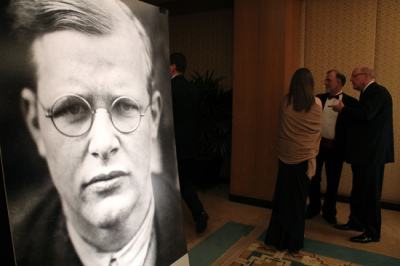Learning from the faith of Dietrich Bonhoeffer

Dietrich Bonhoeffer was born in 1906 to an aristocratic German family. Evidently gifted, he chose to study theology and swiftly graduate with a doctorate at the age of twenty-one. In the first of what were to be many international connections, he worked for two years with a German congregation in Barcelona. He then went to the United States to study for a year at a liberal theological college that he found shallow and uninspiring. He was, however, impressed by the African-American churches he worshipped at, appreciating the congregations’ zeal and sympathizing with the social injustices they endured.
Bonhoeffer returned to Germany in 1931, lecturing and pastoring a church. Horrified by the rise of the Nazis, he spoke out publicly against Hitler from the moment he became Chancellor in 1933. His was not a popular view: many German Christians, encouraged by Hitler’s manipulative use of Christian language, saw him as the nation’s savior.
Bonhoeffer found himself part of the resistance against Nazism. He spoke against the persecution of the Jews and when Hitler demanded a church that swore loyalty to him, Bonhoeffer helped create the Confessing Church, which declared that its head was Christ, not the Führer. Bonhoeffer gained only limited support and, disillusioned by the direction Germany was taking, he went to pastor two German-speaking churches in London. There he would gain even more international connections, having developed friendships with British church leaders.
Returning to Germany, Bonhoeffer was soon denounced as a pacifist and an enemy of the state. In 1937 he became involved in the secret training of pastors for the Confessing Church. He also wrote one of his most important books, The Cost of Discipleship, in which he rebuked shallow Christianity that he termed cheap grace: ‘the preaching of forgiveness without requiring repentance, baptism without church discipline, communion without confession . . . Cheap grace is grace without discipleship, grace without the cross, grace without Jesus Christ, living and incarnate.’ It is a warning that continues to be valid today.
With war looming, Bonhoeffer, committed to peace and refusing to swear allegiance to Hitler, realized that he could be executed. An opportunity to escape conscription appeared with an invitation to teach in the USA. Bonhoeffer took the chance and left in June 1939. Yet once in the States, he realized that he could not be absent from his own country at a time of war and within two weeks took the boat back to Germany.
When war did break out, Bonhoeffer found himself drawn into the circle of those patriotic Germans who sought to overthrow Hitler. In order to again escape conscription, he joined the German military intelligence agency, a body that included many who were opposed to Hitler. On paper, his task was to utilize his many international church connections to advise the military, but in reality, he used them to try to find support for the German resistance.
As the war went on Bonhoeffer found himself on the edges of various plots to assassinate Hitler. Increasingly aware of the horrors the Third Reich was unleashing, he found himself reluctantly concluding that the assassination of Hitler would be the lesser of evils.
In 1943, Bonhoeffer became engaged to Maria von Wedemeyer, but shortly afterward his role in helping Jews escape to Switzerland was uncovered by the Gestapo and he was arrested. At first, he was able to write and receive visitors who supplied him with books and took away his writings; many of these were incorporated into another classic book, Letters and Papers from Prison.
In July 1944, Bonhoeffer’s imprisonment became more severe and he was sent to Buchenwald concentration camp. The accounts we have of him at this time describe him as a man of peace, a man full of grace and kindness, and a man who was occupied in pastoring and counseling those about him.
In the spring of 1945, Bonhoeffer’s name was linked with an old plot against Hitler and his execution was ordered. He was hanged on April 9th, 1945, just two weeks before the camp was liberated. His last recorded words were, ‘This is the end – for me the beginning of life.’
I found the faith of Dietrich Bonhoeffer to have many striking characteristics.
First, his faith was displayed in doing. Bonhoeffer could have stayed an academic theologian quietly writing. Instead, he insisted that Christianity had to be lived out and to be a disciple of Christ was to do something. Beliefs must have consequences: whether it was to work for good or against evil. Bonhoeffer was no armchair Christian and we shouldn’t be either.
Second, his faith was displayed in daring. One of the first German Christians to denounce Hitler, Bonhoeffer worked against Nazism for twelve years, knowing that at any moment he could be – as ultimately he was – arrested, imprisoned, and killed. It’s particularly hard not to be impressed by how, having made it to the safety of New York in 1939, Bonhoeffer then took the boat back to Germany. We could do with a lot more daring today.
Third, his faith was displayed in defying. Faced with a threatening government and a church that remained silent, Bonhoeffer spoke out boldly against both. There are times when we, too, need to stand up and speak boldly.
Finally, and it’s uncomfortable, but Bonhoeffer’s faith was displayed in dying. As he wrote in The Cost of Discipleship, ‘When Christ calls a man, he bids him come and die.’ And with typical consistency that is exactly what Bonhoeffer did.
High above Westminster Abbey’s west door are statues of ten modern martyrs and there stands the figure of Dietrich Bonhoeffer. He deserves that place.
Canon J.John has been an evangelist for 40 years. He has spoken at conferences, universities and in towns and cities across 69 countries on 6 continents. In 2017 he launched JustOne at the Arsenal Emirates Stadium in London, and JustOne events are being conducted throughout the UK. Evangelist, minister, speaker, broadcaster and writer, J.John communicates the Christian faith in a practical way. He has written several books across a range of subjects including the ‘Theology For Little People’ series to help children understand biblical truth. J.John lives near London in England.
Facebook | https://www.facebook.com/canonjjohn
Instagram | https://www.instagram.com/canonjjohn/
Twitter | https://twitter.com/Canonjjohn?s=20




























